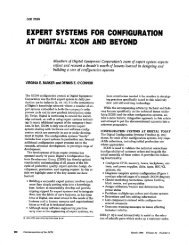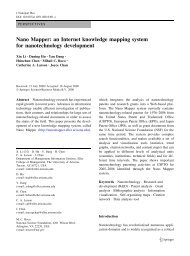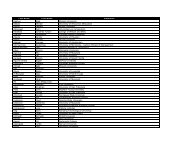Chen et al./Introduction: Business Intelligence ResearchMobile AnalyticsAs an effective channel for reaching many users <strong>and</strong> as ameans of increasing the productivity <strong>and</strong> efficiency of anorganization’s workforce, mobile computing is viewed byrespondents of the recent IBM technology trends survey (IBM2011) as the second most “in dem<strong>and</strong>” area for softwaredevelopment. Mobile BI was also considered by the GartnerBI Hype Cycle analysis as one of the new technologies thathave the potential <strong>to</strong> drastically disrupt the BI market (Bitterer2011). According <strong>to</strong> eMarketer, the market for mobile ads isexpected <strong>to</strong> explode, soaring <strong>from</strong> an estimated $2.6 billion in2012 <strong>to</strong> $10.8 billion in 2016 (Snider 2012).Mobile computing offers a means for IT professional growthas more <strong>and</strong> more organizations build applications. With itslarge <strong>and</strong> growing global install base, Android has beenranked as the <strong>to</strong>p mobile platform since 2010. This opensource platform, based on Java <strong>and</strong> XML, offers a muchshorter learning curve <strong>and</strong> this contributes <strong>to</strong> its popularitywith IT professionals: 70 percent of the IBM surveyrespondents planned <strong>to</strong> use Android as their mobile developmentplatform, while 49 percent planned <strong>to</strong> use iOS <strong>and</strong> 35percent planned <strong>to</strong> use Windows 7. The ability <strong>to</strong> collect finegrained,location-specific, context-aware, highly personalizedcontent through these smart devices has opened new possibilitiesfor advanced <strong>and</strong> innovative BI&A opportunities. Inaddition <strong>to</strong> the hardware <strong>and</strong> content advantages, the uniqueapps ecosystem developed through the volunteer communityof mobile app developers offers a new avenue for BI&Aresearch. The Apple App S<strong>to</strong>re alone offers more than500,000 apps in almost any conceivable category as of August2012; 8 the number of Android apps also reached 500,000 inAugust 2012. 9 Many different revenue models have begun <strong>to</strong>emerge for mobile apps, <strong>from</strong> paid or free but ad-supportedapps <strong>to</strong> mobile gamification, which incentivizes participants(e.g., users or employees) by giving rewards for contributions(Snider 2012). For mobile BI, companies are consideringenterprise apps, industry-specific apps, e-commerce apps, <strong>and</strong>social apps (in ranked order) according <strong>to</strong> the IBM survey.The lightweight programming models of the current webservices (e.g., HTML, XML, CSS, Ajax, Flash, J2E) <strong>and</strong> thematuring mobile development platforms such as Android <strong>and</strong>iOS have contributed <strong>to</strong> the rapid development of mobile webservices (e.g., HTML5, Mobile Ajax, Mobile Flash, J2ME) in8 Apple – iPhone 5 – Learn about apps <strong>from</strong> the App s<strong>to</strong>re (http://www.apple.com/iphone/built-in-apps/app-s<strong>to</strong>re.html; accessed August 8, 2012).9 AppBrain, Android Statistics (http://www.appbrain.com/stats/number-of<strong>and</strong>roid-apps;accessed August 8, 2012).various mobile pervasive applications, <strong>from</strong> disaster management<strong>to</strong> healthcare support. New mobile <strong>analytics</strong> research isemerging in different areas (e.g., mobile sensing apps that arelocation-aware <strong>and</strong> activity-sensitive; mobile social innovationfor m-health <strong>and</strong> m-learning; mobile social networking<strong>and</strong> crowd-sourcing; mobile visualization/HCI; <strong>and</strong> personalization<strong>and</strong> behavioral modeling for mobile apps). In addition,social, behavioral, <strong>and</strong> economic models for gamification,mobile advertising, <strong>and</strong> social marketing are under way <strong>and</strong>may contribute <strong>to</strong> the development of future BI&A 3.0systems.Mapping the BI&A KnowledgeL<strong>and</strong>scape: A Bibliometric Study ofAcademic <strong>and</strong> Industry PublicationsIn an effort <strong>to</strong> better underst<strong>and</strong> the current state of BI&Arelated research <strong>and</strong> identify future sources of knowledge, weconducted a bibliometric study analyzing relevant literature,major BI&A scholars, disciplines <strong>and</strong> publications, <strong>and</strong> keyresearch <strong>to</strong>pics. A collection, transformation, <strong>and</strong> <strong>analytics</strong>process was followed in the study, much like a typical BI&Aprocess adopted in other applications.To discern research trends in BI&A, related literature <strong>from</strong>the past decade (2000–2011) was collected. Relevant ITpublications were identified <strong>from</strong> several large-scale <strong>and</strong>reputable digital libraries: Web of Science (ThomsonReuters, covering more than 12,000 of the highest <strong>impact</strong>journals in sciences, engineering, <strong>and</strong> humanities), BusinessSource Complete (EBSCO, covering peer-reviewed <strong>business</strong>journals as well as non-journal content such as industry/trademagazines), IEEE Xplore (Institute of Electrical <strong>and</strong> ElectronicsEngineers, providing access <strong>to</strong> the IEEE digitallibrary), ScienceDirect (Elsevier, covering over 2,500 journals<strong>from</strong> the scientific, technical, <strong>and</strong> medical literature), <strong>and</strong>Engineering Village (Elsevier, used <strong>to</strong> retrieve selected ACMconference papers because the ACM Digital Library interfacedoes not support au<strong>to</strong>mated downloading). These sourcescontain high-quality bibliometric meta<strong>data</strong>, including journalname <strong>and</strong> date, author name <strong>and</strong> institution, <strong>and</strong> article title<strong>and</strong> abstract.To ensure <strong>data</strong> consistency <strong>and</strong> relevance across our collection,we retrieved only those publications that contained thekeywords <strong>business</strong> <strong>intelligence</strong>, <strong>business</strong> <strong>analytics</strong>, or <strong>big</strong><strong>data</strong> within their title, abstract, or subject indexing (whenapplicable). The choice of these three keywords was intended<strong>to</strong> focus our search <strong>and</strong> analysis on publications of direct relevance<strong>to</strong> our interest. However, this search procedure may14 MIS Quarterly Vol. 36No. 4/December 2012
Chen et al./Introduction: Business Intelligence ResearchKeywordAllYears 2000 2001 2002 2003 2004 2005 2006 2007 2008 2009 2010 2011Business Intelligence 3,146 113 104 146 159 229 330 346 394 352 201 334 338Business Analytics 213 0 5 43 4 5 2 9 6 19 16 17 126Big Data 243 0 1 0 0 7 4 3 26 11 41 44 95Total 3,602 113 110 149 163 241 336 358 426 382 358 356 560Figure 2. BI&A Related Publication Trend <strong>from</strong> 2000 <strong>to</strong> 2011also omit articles that use other BI&A relevant terms (e.g.,<strong>data</strong> warehousing, <strong>data</strong> mining) but not the three specifickeywords in the title or abstract. This kind of limitation iscommon in bibliometric studies. The collected <strong>data</strong> wasexported as XML records <strong>and</strong> parsed in<strong>to</strong> a relational <strong>data</strong>base(SQL Server) for analysis. The number of recordsinitially retrieved <strong>to</strong>taled 6,187 papers. After removing duplicates,the number of unique records <strong>to</strong>taled 3,602.Figure 2 shows the statistics <strong>and</strong> growth trends of publicationsrelating <strong>to</strong> the three search keywords. Overall, <strong>business</strong> <strong>intelligence</strong>had the largest coverage <strong>and</strong> the longest his<strong>to</strong>ry. Thisis consistent with the evolution of BI&A, as the term BIappeared first in the early 1990s. In our collection, <strong>business</strong><strong>analytics</strong> <strong>and</strong> <strong>big</strong> <strong>data</strong> began <strong>to</strong> appear in the literature in2001, but only gained much attention after about 2007. The<strong>business</strong> <strong>intelligence</strong> related publications numbered 3,146,whereas <strong>business</strong> <strong>analytics</strong> <strong>and</strong> <strong>big</strong> <strong>data</strong> publications eachnumbered only 213 <strong>and</strong> 243, respectively. While the overallpublication trend for <strong>business</strong> <strong>intelligence</strong> remains stable,<strong>business</strong> <strong>analytics</strong> <strong>and</strong> <strong>big</strong> <strong>data</strong> publications have seen a fastergrowth pattern in recent years.Knowledge of the most popular publications, as well as prolificauthors, is beneficial for underst<strong>and</strong>ing an emergingresearch discipline. Table 4 summarizes the <strong>to</strong>p 20 journals,conferences, <strong>and</strong> industry magazines with BI&A publications.(The <strong>to</strong>p 20 academic BI&A authors are identified in Table 6.)Overall, the largest source of academic <strong>business</strong> <strong>intelligence</strong>publications was academic conferences. The Conference onBusiness Intelligence <strong>and</strong> Financial Engineering (#1) <strong>and</strong>Conference on Electronic Commerce <strong>and</strong> Business Intelligence(#3) are specialized academic conferences devoted <strong>to</strong><strong>business</strong> <strong>intelligence</strong>. One IS conference ranks #2 in the <strong>to</strong>p-20 list: Hawaii International Conference on Systems Sciences(HICSS), with 370 publications. 10 IEEE holds the majority ofconferences on the list through various outlets; several arerelated <strong>to</strong> emerging technical areas, such as <strong>data</strong> mining,Internet computing, <strong>and</strong> cloud computing. The IEEE InternationalConference on Data Mining (ICDM) is highlyregarded <strong>and</strong> ranks #5. ACM has two publications in the <strong>to</strong>p-20 list: Communications of the ACM <strong>and</strong> the ACM SIGKDDInternational Conference on Knowledge Discovery <strong>and</strong> DataMining. Both are well-known in CS. Again, the <strong>data</strong> miningcommunity has contributed significantly <strong>to</strong> BI&A. Othertechnical conferences in CS are also contributing <strong>to</strong> BI&A inareas such as computational <strong>intelligence</strong>, web <strong>intelligence</strong>,evolutionary computation, <strong>and</strong> natural language processing,all of which are critical for developing future <strong>data</strong>, text, <strong>and</strong>web <strong>analytics</strong> techniques discussed in our research frame-10 Two major IS conferences, ICIS (International Conference on InformationSystems) <strong>and</strong> WITS (Workshop on Information Technologies <strong>and</strong> Systems)may have also published significant BI&A research; however, their collectionsare not covered in the five major digital libraries <strong>to</strong> which we haveaccess <strong>and</strong> thus are not included in this analysis.MIS Quarterly Vol. 36 No. 4/December 2012 15










